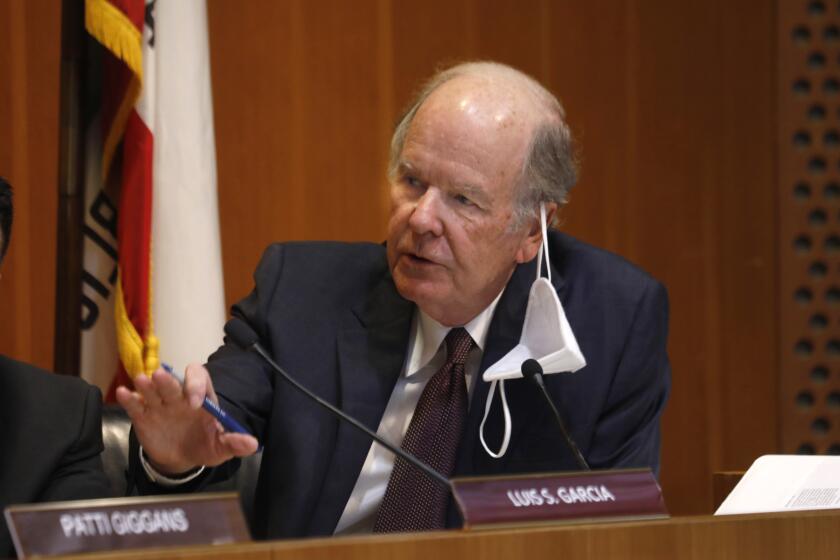California gets new rules covering medical malpractice payments. Here’s what will change

- Share via
SACRAMENTO — Gov. Gavin Newsom signed a bill Monday to raise the amount of money that patients can receive in medical malpractice cases, increasing pain and suffering payments for the first time since lawmakers placed a cap on monetary damages nearly five decades ago.
The governor’s signature on Assembly Bill 35 was the final step in a process that began last month when rival interests groups — doctors and lawyers — announced a deal to avoid a costly battle at the ballot box in November to overhaul the Medical Injury Compensation Reform Act of 1975, known as MICRA.
“After decades of negotiations, legislators, patient groups, and medical professionals have reached a consensus that protects patients and the stability of our health care system,” Newsom said Monday in a written statement.
The law hasn’t changed for 47 years
Then-Gov. Jerry Brown signed MICRA into law in 1975 amid concerns that doctors were retiring or leaving California due to rising insurance premiums, blamed on sizable malpractice awards. Under the law, the state caps pain and suffering awards in medical malpractice cases at $250,000, regardless of how many healthcare providers are found to be negligent.
There is no cap on how much patients can be awarded for damages directly related to medical bills and economic losses, such as lost earnings. Critics contend the 47-year-old cap on pain and suffering severely limits how much injured children, retirees and stay-at-home parents can receive while also discouraging attorneys from taking on the complex cases.
Had the MICRA rules limiting pain and suffering awards been adjusted annually for inflation, the cap would now be $1.3 million. Instead, it has remained at $250,000.
Larger pain and suffering awards after Jan. 1
Under AB 35, the amount patients can be awarded for pain and suffering will increase to $350,000 beginning Jan. 1. That amount will gradually rise over a 10-year period to $750,000. In cases involving a patient’s death, the cap on pain and suffering awards will increase to $500,000 on Jan. 1 and then grows to $1 million over the next decade.
After a decade of increases, the cap would be adjusted annually by 2%.
In addition, a patient would be eligible for up to three payments in lawsuits involving multiple doctors, nurses or hospitals. There will be limits on how those separate payments can be applied, with one pot of money to cover a doctor or nurse’s negligence and another for that of a hospital. A third payment will be allowed for pain and suffering in rare cases involving a separate, unaffiliated provider, bringing the potential total award to $1.5 million.
Who will benefit?
The new provisions apply only to cases filed after Jan. 1 and do not apply to previous or ongoing cases.
“Because this will help other families, it’s a win,” said Charles Johnson, who filed a wrongful death lawsuit after his wife died hours after childbirth in 2016.
“It would be great if it benefited our case, but in this journey I have met so many families who have faced horrible things and now they won’t be turned away, they will get representation,” Johnson said. “It gives me comfort.”
How the deal came together
California will now avoid what would have otherwise been a bruising and expensive political fight. Proponents have been highlighting stories of physician misconduct and medical errors that have had serious, and sometimes deadly, consequences as they made their case for increasing malpractice awards to injured patients. A documentary featuring several California cases is slated to premiere next month at a Los Angeles film festival.
At the same time, the state’s medical board has come under fire for lax punishments against doctors who were repeatedly found negligent in their care. Last year, The Times found that the Medical Board of California had consistently allowed doctors accused of negligence to keep practicing and harming patients, at times leaving them dead, paralyzed, brain-damaged or missing limbs.
A Times investigation in December found that since 2013, the Medical Board of California has reinstated 10 physicians who had lost their licenses for sexual misconduct. They included two doctors who abused teenage girls and one who beat two female patients when they reported him for sexually exploiting them.
However, the measure had a difficult political road ahead.
Nick Rowley, a wealthy trial attorney who bankrolled the effort to gather voter signatures for placing a measure on the ballot, pledged to spend whatever it took to increase the malpractice cap in California. Proponents were up against the deep pockets of hospital, insurance and doctors groups that argued insurance premiums would skyrocket without “MICRA’s essential guardrails,” forcing healthcare providers to close their doors.
The measure removed by last month’s deal would have been the second attempt to win over voters, who overwhelmingly rejected Proposition 46 in 2014. Opponents raised $60 million in that effort and this year’s ballot measure also was headed toward a lopsided campaign spending war before the compromise.
“To get to a compromise on something this significant on all sides, it took the stakeholders to think about the greatest good for their respective members and for the community as a whole,” said Assemblymember Eloise Gómez Reyes (D-Grand Terrace), who was the author of the bill. “For at least a decade we don’t have to revisit this. We can concentrate on other business that needs to be done for California.”
More to Read
Sign up for Essential California
The most important California stories and recommendations in your inbox every morning.
You may occasionally receive promotional content from the Los Angeles Times.














